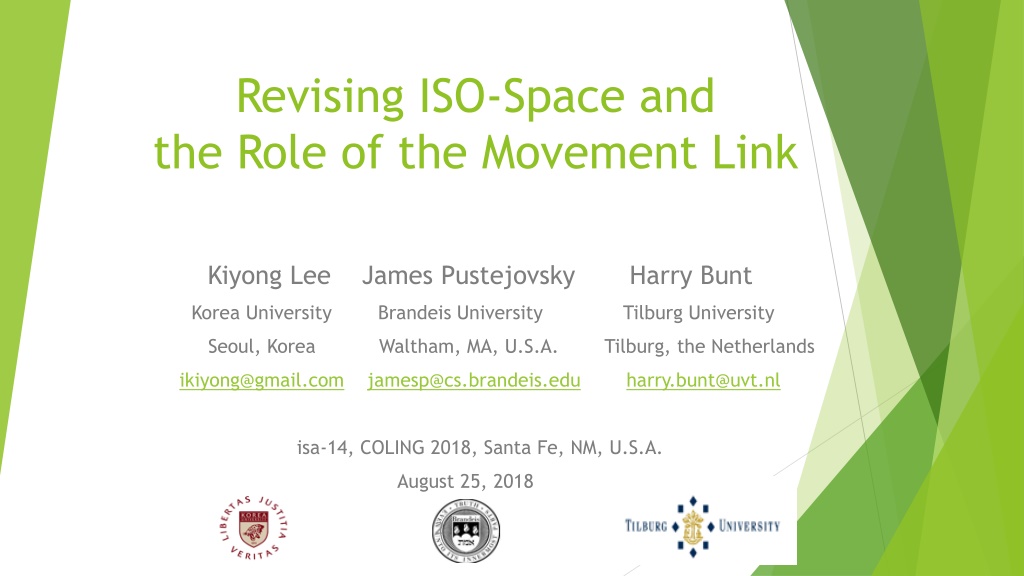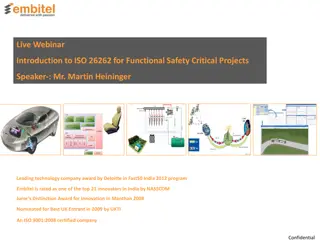Revising ISO-Space and the Role of the Movement Link
The study revisits ISO-Space and its role in annotating static and dynamic spatial information in language. It discusses the revision process, fate, entity structures, link structures, and insights derived from ISO-Space. The research emphasizes the importance of formal semantics in spatial annotation schemes.
Download Presentation

Please find below an Image/Link to download the presentation.
The content on the website is provided AS IS for your information and personal use only. It may not be sold, licensed, or shared on other websites without obtaining consent from the author. Download presentation by click this link. If you encounter any issues during the download, it is possible that the publisher has removed the file from their server.
E N D
Presentation Transcript
Revising ISO-Space and the Role of the Movement Link Kiyong Lee James Pustejovsky Harry Bunt Korea University Brandeis University Tilburg University Seoul, Korea Waltham, MA, U.S.A. Tilburg, the Netherlands ikiyong@gmail.com jamesp@cs.brandeis.edu harry.bunt@uvt.nl isa-14, COLING 2018, Santa Fe, NM, U.S.A. August 25, 2018
Outline 1. What s ISO-Space? 2. Why and How ISO-Space (2014) is Revised? 3. What s the Fate of ISO-Space (2014)? 4. Conclusions and perspectives
1. Whats ISO-Space? ISO-Space is: an ISO standard for the annotation of static and dynamic spatial information in language; an annotation scheme that formally defines annotation structures, consisting of: (1) entity structures and (2) link structures; a semantic annotation scheme with a valid formal semantics.
24617-7:2014 Spatial information ISO-Space Specifies an annotation scheme for 1. static and 2. dynamic spatial information goes beyond the scope of MITRE s SpatialML Dataset: Source: https://www.cbc.ca/news/world/india-bus-accident-1.4730298 1. Date: 2018. 7. 1. 2. 3. Text: At least 48 people were killed on Sunday when an overcrowdedbus plunged off a mountain road into a gorge in northern India, officials said.
generates annotation structures annotation scheme entity structures =<m,s> s=@(entityType) Link structures < ,E, ,[@]> 2..n
Entity Structures An overcorweded busw3 plungedw4 offw5 a mountain roadw8 intow9 a gorgew11 inw12 northern Indiaw14. ep1 <entity xml:id= x1 target= #w3 pred= bus type= vehicle form= nom /> <motion xml:id= m1 target= #w4 pred= plunge tense= past motionType= moveExternal /> <sRelation xml:id= sr1 target= #w5 pred= off type= pathDefining value= start /> <path xml:id= p1 target= #w8 pred= road form= nom /> <sRelation xml:id= sr2 target= #w9 pred= into type= pathDefining value= end /> <place xml:id pl1 target= #w11 pred= gorge form= nom /> <eventPath xml:id= ep1 target= trigger= #m1 start= #p1 end= #pl1 />
Link Structures An overcorweded busx1 plungedm1 ep1 offsr1 a mountain roadp1 intosr2 a gorgepl1 insr3 northern Indiapl2. Dynamic spatial information: Movement Link <moveLink xml:id= mvL1 figure= #x1 ground= #ep1 relType= traverses/plungesThrough trigger= #m1 goalReached= yes /> Static spatial information: Qualitative Spatial Link <qsLink xml:id= qsL1 figure= #pl1 ground= #pl2 relType= IN trigger= #sr3 />
Semantics for ISO-Space semantic annotation scheme isomorphic concrete syntax abstract syntax generates represents validates annotation structures interprets semantics
Basic Assumptions Adoption of the Neo-Davidsonian semantics: 1. Eventualites are treated like individual entities; 2. The semantic role of each event participant is specified. Adoption of DRT,which provides a compositional semantics. The representation of each of DRSs can be simplified by 1. replacing boxes with square brackets; 2. interpreting unbound variables as existentially bound variables; 3. representing conjunctions with commas. Intepretation: An overcrowded busx1 plungedm1 ep1 offsr1 a mountain roadp1 intosr2 a gorgepl1 insr3 northern Indiapl2. (pl1) := [gorge(l1)], where is an interpretation function; (pl2) := [named(l2, northern India ), region(l2), countryOf(India,l2)]; (qsL1) := [in(l1,l2)]; (a gorgepl1 insr3 northern Indiapl2) := [ (pl1) (pl2) (qsL1)]
2. Why and How ISO-Space is Revised? Why? Refer to: Pustejovsky et al. (2010) Pustejovsky and Yocum (2013) Bunt et al. (2016) ISO 24617-6: 2016 Principles of semantic annotation Lee (2016) Pustejovsky and Lee (2017) Lee (2018)
How is ISO-Space (2014) Revised? By implementing event-paths in concrete syntaxes, capturing the axiom of (translocational) motion-events, distributing various sorts of information to appropriate annotation structures, and properly formulating the movement link, <moveLink>, to capture the axiom of motions to be discussed.
metamodel met communicative segments isSourceOf markables isAnchoredTo isAnchoredTo isAnchoredTo isAnchoredTo spatial relation eventuality measure triggers spatial entity 2..n 1..1 1..1 motion qsLink/oLink mLink location 1..1 triggers 1..1 qsLink_e/ oLink_e path place trajectory (event-path) 1..1 moveLink 1..1 Metamodel of Revised ISO-Space
Three Tasks The revision of ISO-Space (2014) is aimed at: Implementing the event-path <eventPath> in concrete syntaxes to make each of the concrete syntaxes isomorphic to their abstract syntax; Reformulating the movement link <moveLink> to make it conform to the general link structure < , E, >; Reallocating attribute assignments to relevant entity structures to distribute various types of information to their associated entity types.
Axiom on Motions and Event-paths Every motion-event triggers a trajectory or route, called event-path, that a mover traverses: e[motion(e) {r,x}[eventPath(r) triggers(e,r) mover(x,e) traverses(x,r)]]
Axiommotion and the Role of <moveLink> e[motion(e) {r,x}[eventPath(r) triggers(e,r) entity(x) mover(x,e) traverses(x,r)]] <moveLink xml:id= mvL1 ground= ep1 trigger= m1 figure= x1 relType= traverses /> Interpretation (mvL1) := ( m1)[motion(m1) [eventPath(r1), trigger(m1,r1), entity(x1), mover(x1,m1), traverses(x1,r1)]] (mvL1) = Axiomm
Distribution of Information ISO-Space (2014) revised ISO-Space comment <moveLink> identifier [trigger] figure ground relType [goalReached] [comment] <moveLink> identifier [trigger] [mover] [ground] [goalReached] [source] [goal] [midPoint] [pathID] [motionSignal] [comment] <motion> [goal] [motionManner] <eventPath> identifier trigger start end [mids] [comment] path-defining
3. Whats the Fate of ISO-Space (2014)? What about all the work done by using ISO-Space (2014)? When ISO-Space (2018), the revised version, is published as the second edition of ISO 24617-7, does all the work need to be updated? Well, sometimes all editions are found valuable.
Two Claims about ISO-Space (2014) Weak Claim: semantic compability Strong Claim: semantic equivalence
Weak Claim ISO-Space (2014) is semantically compatible with its revised version. ISO-Space (2014) ISO-Space (2018)
Operational Definitions of Semantic Compatibility Definition 1 (comparable at the annotation level) Given two versions, v1 and v2, of a semantic annotation scheme, v1 is semantically compatible with v2 only if the information annotated by v1 is also annotated by v2 independent of how it is annotated. Definition 2 (comparable at the interpretation level) Given two annotation schemes, AS1 and AS2, and an interpretation function , AS1is semantically compatible with AS2 if (AS1) is entailed by (AS2).
Semantic Compatibility Illustrated Dataset 1: Johnx3 drovem3 ep1 tosr1 Worcesterpl1 onsr2 the Massachusetts Turnpikep1. <isoSpace xml:id= is1 > <moveLink xml:id= mvl1 trigger= #m3 mover= #x3 goalReached= yes goal= #pl1 pathID= #p1 /> </isoSpace> <isoSpace2018 xml:id= is1 > <motion xml:id= m3 target= #w2 pred= walk tense= past goal= #pl1 /> <eventPath xml:id= ep1 target= start= end= #pl1 mids= #p1 /> <moveLink xml:id= mvL1 trigger= #m3 figure= #x3 ground= #ep1 relType= drivesThrough goalReached= yes /> </isoSpace2018>
Strong Claim ISO-Space (2014) + Axiommotion is equivalent to its Revision Given an interpretation over annotation structures, (ISO-Space2014 ) + Axiommotion (ISO-Space2018) A Nice Exercise to show the equivalence
4. Conclusions and Perspectives Compatibility between two versions of an annotation scheme applies either at the abstract syntax, concrete syntax, or semantics level. Semantic compatibility is a minimum requirement for a revision. From such a compatibility perspective, the ISO working group on semantic annotation has been revising ISO-Space (2014) into ISO-Space (2018). ISO-Space (2018) introduces event-paths or trajectories, triggered by motions, to its annotation scheme, while distributing semantic information associated with attribute assignments to appropriate annotation structures. Consequently, ISO-Space (2018) adequately annotates dynamic information in language in more explicit terms, conforming to ISO 24617-6 Principles of semantic annotation (2016) and being interoperable with other related semantic annotation frameworks such as ISO 24617-1 TimeML (2012). ISO-Space (2018) is expected to be an ISO international standard by the end of 2019 or early 2020.
Intepretation Based on <isoSpace2> for Annotation 1 i(x3) := [person(x), named(x3, John )]; i(m3) := [drive(m3), past(m3), goal(l1,m3)]; i(l1) := [city(l1), named(l1, Worcester )]; i(p1) := [path(p1), named(p1, the Massachusetts Turnpike )] i(ep1) := [eventPath(r1), triggeredBy(r1,m3), startsAt(r1,l2), endsAt(r1,l1), overlaps(r1,p1)]; i(mvL1) := [drivesThrough(m), mover(x3,m3), path(r1,m3), m=m3, reached(x,l1)]
Semantic Equivalence Illustrated ISO-Space (2018) (mvl1) Axiommotion= [drive(m3), moverOf(x3,m3), goalOf(pl1,m3), (mvl1) Axiommotion= [drive(m3), moverOf(x3,m3), goalOf(pl1,m3), reached(x3,pl1), pathOf(p1,m3)] [eventPath(ep1), triggeredBy(ep1,m3)] pathOf(p1,m3)] [eventPath(ep1), triggeredBy(ep1,m3)] ISO-Space2 (ep1) = [drive(m3), eventPath(ep1), startAt(ep1,l1), endAt(epl,l1), overlaps(p1,ep1), triggeredBy(ep1,m3)] (mvL1) = [drive(m3), moverOf(x3,m3), goalOf(pl1,m3), reached(x3,pl1)]























